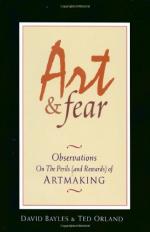|
This section contains 502 words (approx. 2 pages at 400 words per page) |

|
Art & Fear: Observations on the Perils (and Rewards) of Artmaking Summary & Study Guide Description
Art & Fear: Observations on the Perils (and Rewards) of Artmaking Summary & Study Guide includes comprehensive information and analysis to help you understand the book. This study guide contains the following sections:
This detailed literature summary also contains Topics for Discussion and a Free Quiz on Art & Fear: Observations on the Perils (and Rewards) of Artmaking by David Bayles.
Art and Fear is a non-fiction book written by artists for artists. The point of the book is to help the young and/or struggling artist survive in the art world and to conquer the various difficulties, obstacles and fears that the developing artist faces. These difficulties come in two varieties: internal and external. Internal obstacles are those obstacles that the artist has within herself, such as fears about herself, fears of others, an inability of the artist to find her own work. External obstacles are the difficulties one faces in the world of art, such as managing art production, finding time to pursue one's own work, teaching in the academy, interacting with the art community, managing one's art network, and so on. The authors divide the book into two parts, the first concerns internal problems, those associated with the individual creation of art; the second part concerns external problems, dealing with the outside, academic and conceptual worlds.
The first chapter describes the nature of the problem that the artist faces. Creating art is hard. It requires one to learn skills; it is much more than talent. The artist often thinks she can learn how to create art by looking at it. Further, the artist has to tango with the art establishment. The artist is under many false impressions and is the slave of her fear and her external world. Chapter two covers the relationship between art and fear. Fear in art is made possible because there is a gap between one's vision for a work of art and the execution of that art. Failure is always possible. Imagination creates fear because it can always outstrip one's abilities. Materials create fear because one can be in short supply or unable to decide what materials to use. Uncertainty creates fear for the most obvious of reasons. Chapter three covers fears one might have about one's self, such as that one is a poseur or lacking in talent. Chapter four discusses fears about others, fears that one will be misunderstood, rejected by the community or disapproved of. The fifth chapter aims to help the artist find her own work through conquering these fears.
Part II contains the remaining four chapters. Chapter six discusses problems with the outside world generally, including managing one's art production, handling competition with other artists, and so on. Chapter seven focuses on how to handle the academic world, not only as a faculty member but as a student or a book writer. Chapter eight covers all the external "conceptual" difficulties the author must tackle, such as maintaining one's habits, being creative, and developing one's craft. In chapter nine, the authors encourage the reader to ask important questions to come to her own answers about how to be the best artist she can be. They emphasize that all artists have a free choice to give art their all or to decide to disappoint themselves. They can choose to risk failure, or they can accept it without trying.
Read more from the Study Guide
|
This section contains 502 words (approx. 2 pages at 400 words per page) |

|



